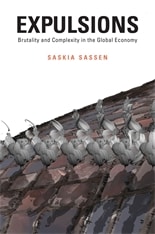Expulsions: Brutality and Complexity in the Global Economy by Saskia Sassen. Harvard University Press. ISBN 9780674599222. 304 pages.
A review by D.T. Cochrane
With Expulsions, Saskia Sassen joins a growing effort to reconceptualise critical political economy (Cetina and Preda 2004; Swedberg and Pinch 2008; Nitzan and Bichler 2009; Latour 2013). Especially in the wake of the 2007-08 financial crisis, there is a sense of urgency that our existing analytical apparatus, largely rooted in Marxian terms and practices, is unsuited to the task of understanding the contemporary institutions and processes that make up ‘The Economy’: itself a broad and problematic concept.
Although Sassen seeks to expose hidden systemic trajectories, she offers a familiar temporal perspective on post-war Keynesianism, “a space of incorporation,” transforming into neoliberalism, whose contemporary ‘systemic edge,’ is “a space of expulsions” (Sassen 2014, 221).
The title concept is intended to inform empirical research into the destructive forces shaping global societies that “cut across our conceptual boundaries—the terms and categories we use to think about the economy, the polity, [and] the diversity of nation-states and ideologies” (Sassen 2014, 215). Unfortunately, the book falls short of Sassen’s important ambitions. It is an informative read, and the concept of expulsions has analytical merit and potential. However, when Sassen resorts to a standard rendering of epistemic breaks in 20th century capitalist economies, she undermines her project.

While the epistemic break with Keynesianism is not untrue, its reflexive use hampers our analyses in precisely the way Sassen criticises. We lose track of some important continuities as well as other transformations relevant to the systemic dynamics. This is unfortunate as Sassen’s previous work positions her to challenge the standard dichotomy (Sassen 1991; Sassen 1998; Sassen 2000). Such a challenge is necessary to understanding the historical roots of the destructive, expulsive forces she wishes to reveal.
Sassen acknowledges that the Keynesian era had its problems, such as the systemic exclusion of women and minorities from the protections of unionisation (Sassen 2014, 27). However, this acknowledgement does not undo the ‘Golden Age’ idealism present in the analysis. She celebrates the era for its high employment and productive output. Yet, the contradictions of those years emerge with Sassen’s own empirical evidence. Sassen highlights various sorts of environmental degradation—from mercury poisoning to mountaintop removal mining to costal dead zones—as examples of expulsion of the biosphere (Sassen 2014 ch. 4). However, much of today’s environmental horrors originate in the ‘productivity’ of the Keynesian era. For example, increased agricultural output relied on increased fertiliser use that has contributed to the coastal dead zones. Inclusion and expulsion are not as neatly temporal as Sassen’s construction. The inclusion of new products into systems of production had expulsion as a consequence.
The concept of expulsion may have potential, less in identifying a new phase of social order and more in understanding how inclusion and expulsion function together to create breaks and maintain continuities. Consider one of the processes hidden by Sassen’s temporal bifurcations: the struggles of North American indigenous peoples. During the Keynesian era, residential schools were still a prominent feature of the Canadian and U.S. governments’ relationships with First Nations. The purpose of the schools was to assimilate—include—the indigenous populations into mainstream society. However, in doing so they disallowed the students from observing the practices of their own societies, expelling from them their indigenous culture (Churchill 2004).
This policy to ‘save the man, kill the Indian’ dates back to late 19th century and continues, in various forms, until today. While the Canadian government has formally apologised for the residential schools, attempts to assimilate those of First Nation descent are ongoing. These efforts are conjoined to environmentally destructive projects like the Alberta tarsands. Governments tout these projects for the jobs and economic benefits they will reportedly bring to indigenous communities. While these populations are to be included in the workforces exploiting natural resources, their traditional rights are to be expelled as part of the development.
The intertwining of inclusion and expulsion is also found in the financial events that Sassen analyses. Subprime mortgages enrolled marginal communities into the financial system. With the global financial crisis, these communities were disproportionately expelled only to then be preyed upon by payday lenders and other extortionist financial institutions. We can find a similar experience during the late-19th and early-20th century boom-bust cycles that saw the creation of a middle class reliant on debt and, in times of crisis, bankruptcy (Sandage 2005; Hyman 2011). Indebtedness enables people to smooth their consumption over lifetimes that include periods of under- and unemployment, while it also serves a disciplinary function (Graeber 2011). Inclusion is not inherently a good thing. Bankruptcy, on the other hand, although an expulsion, also freed people from the strictures of indebtedness: expulsion is not necessarily a bad thing (Moten and Harney 2013).
The project of reconceptualising political economy is an important, and timely, one. The concept of expulsion is useful. However, its uses need further exploration and development. This could help us more fully accomplish what Sassen intended, with epistemic breaks associated with widespread or large-scale expulsions and inclusions, and continuities identified with cycles of inclusion and expulsion. This may allow us to cut through the concepts that Sassen identifies as well as the ones she unfortunately retains.
Cetina, Karin Knorr, and Alex Preda, (eds.). 2004. The Sociology of Financial Markets. USA: Oxford University Press.
Churchill, Ward. 2004. Kill the Indian, Save the Man: the Genocidal Impact of American Indian Residential Schools. San Francisco: City Lights Publishers.
Graeber, David. 2011. Debt: the First 5,000 Years. New York: Melville House.
Hyman, Louis. 2011. Debtor Nation: the History of America in Red Ink. Princeton, NJ: Princeton University Press.
Latour, Bruno. 2013. An Inquiry Into Modes of Existence. Harvard University Press.
Moten, Fred, and Stefano Harney. 2013. The Undercommons. Minor Compositions.
Nitzan, Jonathan, and Shimshon Bichler. 2009. Capital as Power: a Study of Order and Creorder. London: Routledge.
Sandage, Scott A. 2005. Born Losers: a History of Failure in America. Cambridge, MA: Harvard University Press.
Sassen, Saskia. 1991. The Global City: New York, London, Tokyo. Princeton, NJ: Princeton University Press.
Sassen, Saskia. 1998. Globalization and Its Discontents. New York: The New Press.
Sassen, Saskia. 2000. Cities in a World Economy. 2nd ed. Thousand Oaks, CA: Pine Forge Press.
Sassen, Saskia. 2014. Expulsions: Brutality and Complexity in the Global Economy. Cambridge, MA: Harvard University Press.
Swedberg, Richard, and Trevor Pinch, (eds.). 2008. Living in a Material World: Economic Sociology Meets Science and Technology Studies. Cambridge, MA: MIT Press.






